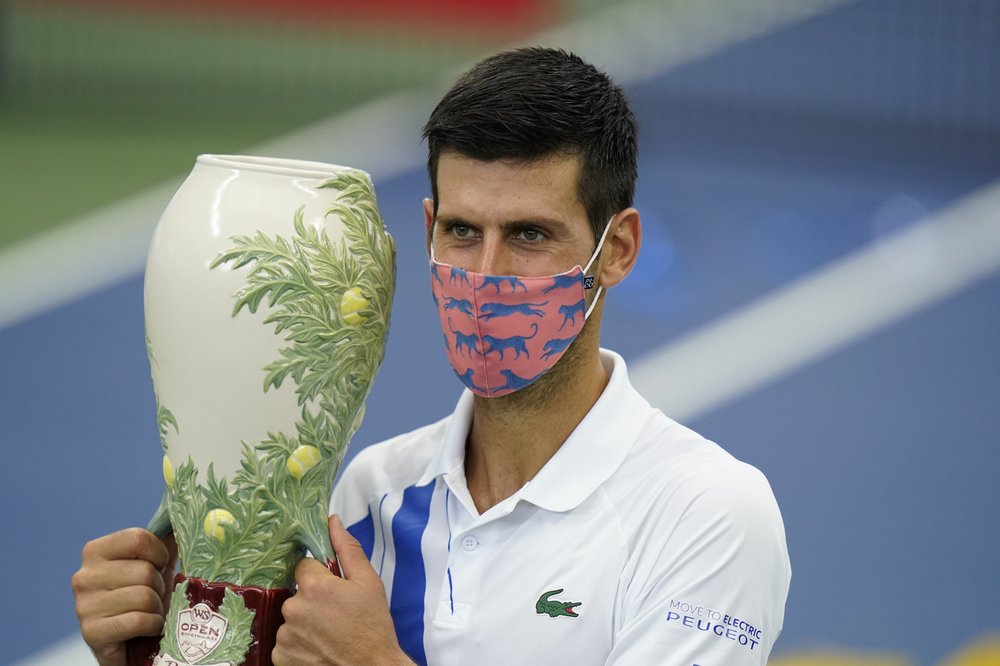
Djokovic wins 35th Masters; Osaka withdraws from final due to injury
For all that has been on Novak Djokovic's plate of late, including a painful neck and his efforts to start a new players' association, when it comes to men's tennis, he is perfect, making it an ideal way to head into the U.S. Open.

For all that has been on Novak Djokovic’s plate of late, including a painful neck and his efforts to start a new players’ association, when it comes to men’s tennis, he is perfect, making it an ideal way to head into the U.S. Open.
Djokovic tied Rafael Nadal’s record by earning his 35th title at a Masters 1000 tournament, overcoming a sluggish start to beat Milos Raonic 1-6, 6-3, 6-4 in the Western & Southern Open final on Saturday (August 29) and improve to 23-0 this season.
“Has been challenging mentally and emotionally for me to stay sane and be able to compete on the highest level and win this title,” Djokovic said. “Going on an unbeaten run so far this year obviously brings even more confidence each match.”
Djokovic, 11-0 head-to-head against 2016 Wimbledon runner-up Raonic, goes into the U.S. Open as the No. 1 seed and a big favorite. The Grand Slam tournament begins on Monday (August 31).
“What is that, 23-0?” Raonic said playfully during the trophy ceremony. “Honestly, if I start the year off 3-0, I’m pretty happy.”
Earlier on Saturday, Victoria Azarenka won her first tour title since 2016 when Naomi Osaka pulled out of the women’s final because of a left hamstring injury.
“I just hope I’m giving myself, you know, the opportunity and the chance to have enough time (to recover ahead of the U.S. Open),” Osaka said.
The Western & Southern Open normally is held in Ohio but was moved to Flushing Meadows this year because of the coronavirus pandemic as part of a two-tournament “controlled environment.”
Djokovic will be seeking his 18th Grand Slam title, which would move him one behind Nadal and two behind Roger Federer’s men’s record of 20. Neither of those rivals is entered in the U.S. Open although both spoke out via Twitter on Saturday against Djokovic’s bid to start a new group to represent men’s tennis players.
“We want to have our own organization and association that is 100% ours,” Djokovic said.
On court, Djokovic was listless in the first set, looking exactly the way one might have expected given that he labored through a three-hour semifinal a day earlier, when he repeatedly grabbed his stomach and twice had his neck massaged by a trainer.
It took all of 30 minutes for Raonic, a Canadian ranked No. 30, to take that set. But Djokovic asserted himself in the second set, breaking to lead 3-2 with a backhand passing shot and raising his right fist.
In the third, Djokovic broke twice more, and eventually the 33-year-old from Serbia was raising his arms to mark his 80th career title and 61st on hard courts. Jimmy Connors holds the men’s record of 109 titles; the only others ahead of Djokovic are Federer, Ivan Lendl and Nadal.
Djokovic also won the Western & Southern Open in 2018 and is now the first man to win each Masters 1000 event one level below the Grand Slams at least twice.
Osaka initially felt a problem with her leg in her first match of the Western & Southern Open and said she pulled the hamstring in the second-set tiebreaker of her semifinal Friday.
She called this an “emotional week.”
The 22-year-old Osaka brought the push for racial justice to the tennis tour by saying she was not going to play in her semifinal, joining athletes in other sports sitting out in reaction to the shooting by a Wisconsin police officer of a Black man, Jacob Blake.
Osakas stance prompted the tournament to say it was taking a “pause” to back the cause and scrapping all scheduled matches for Thursday. When play resumed Friday, Osaka competed, saying she was glad the matter got attention.
During his runner-up speech Saturday, Raonic said: “I’m a strong believer that were very lucky up in Canada that every single person walking on a street can feel safe and I hope that there is some serious change that goes on through the U.S., and that every Black man, woman, child can feel safe in their own communities, on the streets.”

